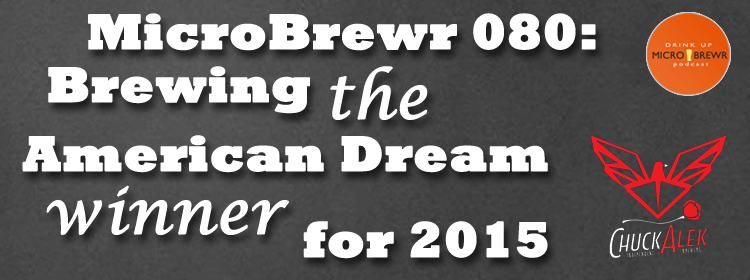MicroBrewr 080: Brewing the American Dream winner for 2015
Podcast: Play in new window | Download | Embed
Subscribe: RSS
A friend asked Marta Jankowska and her husband whether they wanted to use his warehouse space and go pro with their brewing. The warehouse space fell through, but they were far along in the process, so they decided to go for it and opened ChuckAlek Independent Brewers in Ramona, California.
“Your time is so much more valuable actually planning on how to grow the business.” [Tweet This]
“Even though that original space fell through,” says Marta, “we were already so far along in planning that we just decided to go for it.”
They had run the financials, lined up some money from friends and family, and were ready to go. They just needed space.
They found the permitting requirements in the City of San Diego to be cumbersome and expensive, so they finally settled in Ramona, a little town in San Diego County wine country.
“More importantly,” Ramona explains, “we never wanted to be a warehouse brewery. We always wanted to be kind of a main street brewery. Something that was integrated in with community and surrounded by other storefronts.”
By chance, Marta was a tennis partner with one of the founders of Stone Brewing. He told her that over a hundred breweries were starting or being planned for opening in San Diego.
“How are you going to differentiate yourself?” he asked Marta. “The way that I see a brewery doing well in this town is having a really solid background story and a really solid concept. You need to come up with something that has a compelling story that you can tell to the consumer.”
To come up with a compelling story, Marta suggests you think about:
- What you want the brewery to encompass
- What message you want to communicate to the consumers
“A flashy label will get you that fist glimpse from a consumer,” she says. “But people are finicky these days, they’re not super brand loyal, they’re not going to remember something unless it really stands out in their brain, or you give them that nugget that they’re really able to hang onto.”
ChuckAlek has gotten some notoriety this year by being selected as the 2015 recipient of Samuel Adams Brewing the American Dream “experienceship.” They beat out others for apprenticeship, partner brew with Sam Adams, and a trip to Germany with Pink Boots Society.
Other tips from Marta:
- Set aside time to plan for the growth of the business during the next few years.
- Enroll yourself in a business mentorship program.
- Start with the barebones, just to get off the ground. Then buy more equipment when you have the disposable income.
- Build a nest egg for repairs and other unexpected expenditures.
Marta’s suggested software systems for a startup nanobrewery:
- Google Drive, cloud storage and file backup.
- Google Sheets, create and edit spreadsheets online, for free.
- QuickBooks Online, accounting software package.
- BeerSmith, brewing.
- SalesForce, CRM and cloud computing.
- Squarespace, build a website.
Brewery specs:
Kettle size: 1 BBL.
Size and quantity of fermentation tanks: 6, 3-BBL plastics; 1, 2-BBL stainless; 1, 4-BBL stainless; 1, 5-BBL stainless.
Size and quantity of bright tanks: 1, 5-BBL.
Annual brewing capacity/last year’s production: 250 BBL. This year on track to be at about 400 BBL.
Square footage: 1,700 sq. ft.
Years in operation: 2.5 years (opened January 2013).
Listener question:
From Grant Aguinaldo: What software systems do you use to manage your brewery?
Can’t-go-without tool:
Brite Tanks.
Book recommendation:
- Brew Law 101: A Legal Guide to Opening a Brewery – California Edition by Candace L. Moon, Esq. and Stacy Allura Hostetter.
Check out the entire list of recommended books, click here.
An upcoming beer style:
Lager
Other resources:
- Accion, small business lending partners.
- Small Business Development Centers, U.S. Small Business Administration.
- Samuel Adams, Brewing the American Dream; increases the success of small food, beverage, craft brewing, and hospitality businesses.
- Samuel Adams Brewing the American Dream Brewing & Business Experienceship: A Q&A with ChuckAlek Independent Brewers, Sam Adams Editorial Team, November 6, 2014.
- ProBrewer, serving all trades of the specialty beer business.
- Brewers Association, to promote and protect small and independent American brewers.
- Find A State Guild, Brewers Association.
- Pink Boots Society to empower women beer professionals to advance their careers in the beer industry through education.
You can reach Marta Jankowska and ChuckAlek Independent Brewers at:
Sponsors:
Download a free audiobook.
Support MicroBrewr
Help keep MicroBrewr on the air. CLICK HERE for ways you can help.








